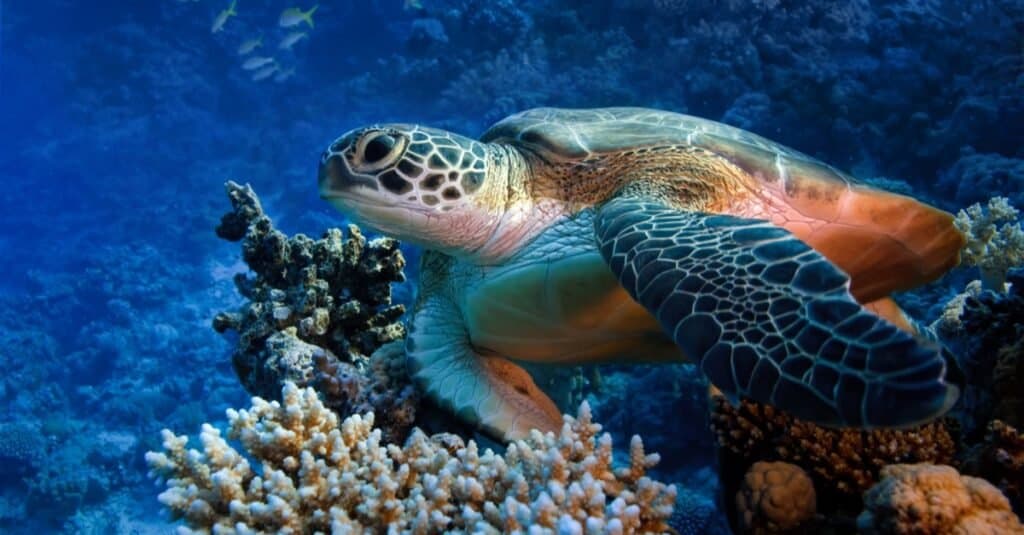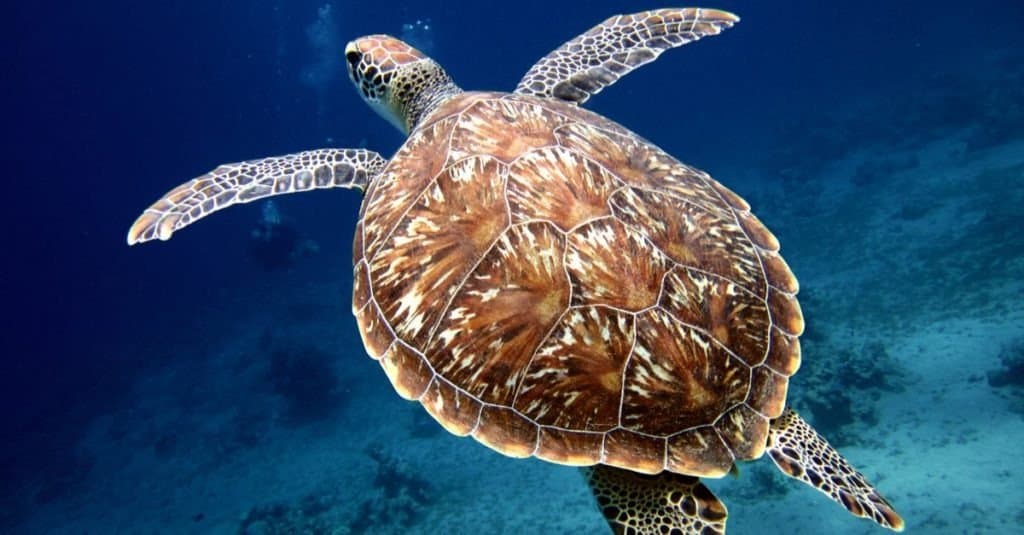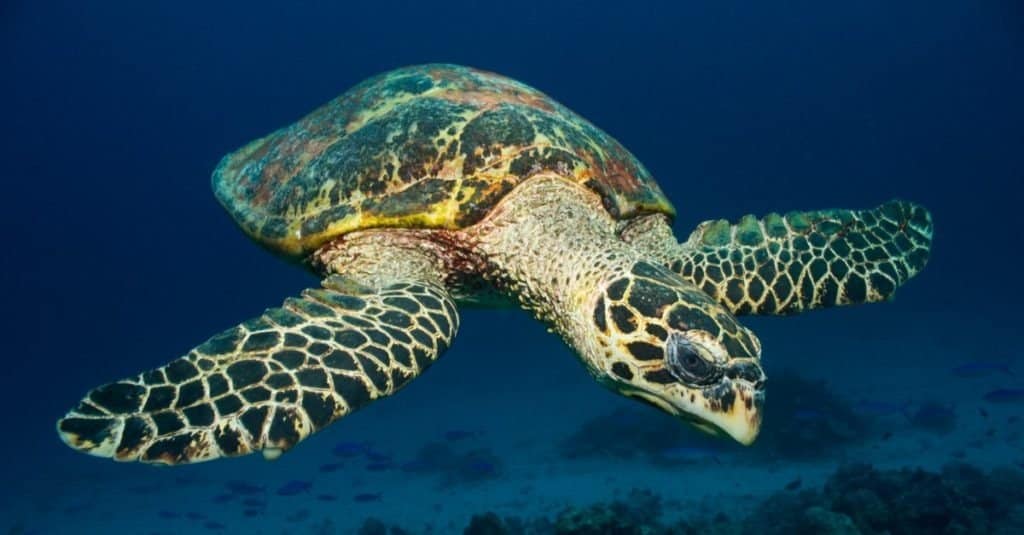Having been around for approximately 110 million years, sea turtles are one of the oldest types of animals alive today and were even around during the time of the dinosaurs. These magnificent reptiles, also known as marine turtles, rarely spend any time at all on land and can reach a weight of around 1,500 pounds.
But just how big can sea turtles get? We’ll look at the largest sea turtle in the world and then take a peek at the largest sea turtle ever found in the world’s oceans!
The Background on Sea Turtles
Sea turtles are found all around the world except for the polar regions and have a life expectancy of more than 50 years, although some can live for much longer. Their shells are a different shape to freshwater turtles and are much more tapered at each end which means that they cannot retract their head or their limbs as protection against predators. Their limbs are actually flippers which makes them extremely vulnerable when they are on land, but allow them to swim effortlessly in the sea and reach a top speed of around 20mph.
There are seven species of sea turtle in the world at the moment, and depending on which species they are, sea turtles can be a range of colors – including olive green, yellow, green-brown, red-brown, and black. There are six hardshell species – hawksbill, olive ridley, Kemp’s ridley, green, loggerhead, and flatback (native only to Australia).

Sea turtles can hold their breath for up to seven hours.
©Willyam Bradberry/Shutterstock.com
The final – and biggest – species is the leatherback whose shells are more supple and are like leather, hence their name. Leatherback sea turtles can reach up to 1,500 pounds and have an average length of 5 feet. They also dive deeper and travel further than any of the other species and even hold the title of being the largest non-crocodilian reptile in the world.
They are capable of moving pretty fast too and have been recorded as swimming at speeds of 35 mph. One other factor that is remarkable about them is their ability to thrive in temperate as well as tropical waters. They are able to do so as a result of their ability to maintain a body temperature that is higher than their surroundings in cold water.

Sea turtles start life as tiny 2-inch-long hatchlings
©zulkamalober/Shutterstock.com
Although leatherbacks are the largest species of sea turtle, the others can get pretty big too. Green sea turtles are the next largest species with an average weight of 300 pounds and a length of 4.5 feet. The third largest species is the loggerhead which can reach 4 feet while weighing an average of 250 pounds. There is no size difference between males and females in any of the sea turtle species.
Most sea turtles are omnivores and eat a range of seaweed, jellyfish, squid, barnacles, and other small organisms, however, the green sea turtle is a herbivore and feeds exclusively on seagrass and algae. Sea turtles have adapted to their habitat and use their front flippers to swipe and hold food while they eat it. Although they need to breathe air to survive, sea turtles can remain underwater for up to 40 minutes while they are foraging and even up to 7 hours when they are sleeping.

The Largest Sea Turtle Ever Recorded
The world record was set on 23rd September 1988 on Harlech Beach in Gwynedd, Wales when a male leatherback turtle was washed ashore after becoming tangled in fishing nets. In fact, this giant set several records as it measured 9 feet and 5.5 inches from the tip of its beak to the tip of its tail, while weighing a massive 2,019 pounds. Not only that but it was actually estimated to be around 100 years old at the time of its death.
Incredibly, the Wildlife Trust received a phone call from a farmer saying that a “monster” had washed up on the beach that was bigger than a cow and the shape of a Volkswagon Beetle car! Upon hearing the news of this huge specimen, Cardiff Museum immediately said that they wanted it, so the Wildlife Trust got it onto a trailer and drove it to Cardiff the next morning. At the museum, they hired a crane to lift the giant turtle, but it was so heavy that it caused all of the weight warning alarms to go off on the crane. The massive leatherback was preserved and has been on display in the National Museum of Wales since 16th February 1990 where it remains to this day.

Some sea turtles can grow to be 9 feet long
©Kjeld Friis/Shutterstock.com
Giant Sea Turtles From Long Ago: A 15-Pound Prehistoric Species that was the Largest Sea Turtle to Ever Live!
Today, the largest sea turtles in the world are leatherbacks that can reach more than nine feet long. However, the largest sea turtle to ever live was named Archelon, and roamed the Earth during the time of dinosaurs.
Archelon measured up to 15 feet in length from its head to tail. When measuring flipper to flipper, Archelon was 13 feet wide. Finally, the giant ancient sea turtle weighs up to 4,900 pounds, or roughly 2.5 times the size of today’s largest sea turtles!

A skeleton of
Archelon©Reimar/Shutterstock.com
Archelon lived in the late Cretaceous Period and went extinct around the same time as the dinosaurs. Today, the last traces of Archelon can only be found in museums, as modern sea turtles don’t trace their lineage back to this giant species.
How do Sea Turtles Compare with Other Turtles?
Despite not being as large as the now-extinct sea turtles from the Late Cretaceous period, sea turtles nowadays are still doing pretty well size-wise against other types of turtles.
The loggerhead is recorded as being the largest hardshell turtle alive today while the leatherback is the largest reptile in the order Testudines which includes all turtles, terrapins, and tortoises. By comparison, the largest land turtle is the alligator snapping turtle which reaches a length of 30 inches and a weight of 225 pounds. Even the largest freshwater turtle – the Yangtze softshell turtle – only reaches a length of 39 inches and has a weight of 220 pounds, meaning that sea turtles are far, far larger than their counterparts.

Sea turtles are far bigger than any other type of turtle in the world
©John Back/Shutterstock.com
Before They’re Giants: Sea Turtles Begin Life As Tiny Hatchlings
Male sea turtles never come ashore and spend their entire lives in the water, while females only come ashore to lay their eggs. Females don’t mature until they are 10 to 15 years old and during each breeding season (which can be between one and nine years apart) they lay several clutches of eggs.
During the cover of night, the female will usually come ashore and dig a circular hole around 20 inches deep in the sand with her hind limbs and then lay her eggs in it. In each clutch there can be between 60 and 180 soft-shelled eggs laid by the female. After laying them she will fill the hole in again and then cover it with vegetation. Amazingly, she might also dig several decoy holes to throw predators off the scent, before returning to the sea and leaving the eggs unattended. The whole process only takes between 30 and 60 minutes.
After 60 days the eggs will hatch and young sea turtles, known as hatchlings, are born. However, sea turtles really do go to the extremes in the size department as they are actually tiny when they hatch – only being around 2 inches long. Once they have hatched, the hatchlings dig their way out of the nest through the sand and head for the sea where they will spend their first few years out in the open water before traveling closer to the coast as they reach adulthood. One of the most fascinating things about sea turtles is that the sex of the hatchlings is determined by the temperature of the sand around the nest. Usually, if the nest is below 82°F then they will be male, but if it is above 87°F then they will be female.
The eggs and hatchlings are at risk from a number of predators including, birds, crabs, fish, and raccoons. Due to their size, adults don’t have many natural predators other than large sharks and crocodiles. However, the main danger to sea turtles is us humans as they are often caught up in fishing nets as bycatch and climate change is causing a lot of their nesting sites to disappear.
Not only that, but pollution and plastic waste can be a major problem for these giants as they often eat plastic which puts them at great risk of illness or death. Sadly, this means that all of the species of sea turtle are under threat – leatherbacks and olive ridleys are classed as vulnerable, loggerheads and greens are classed as endangered, while hawksbill and Kemp’s ridley sea turtles are critically endangered. There is no data on the IUCN red list for flatback sea turtles, but they are classed as an endangered species in their native Australia.
The photo featured at the top of this post is © Achimdiver/Shutterstock.com
Thank you for reading! Have some feedback for us? Contact the AZ Animals editorial team.






